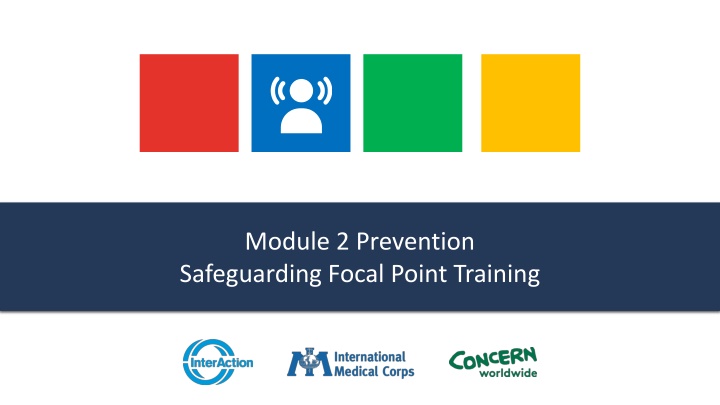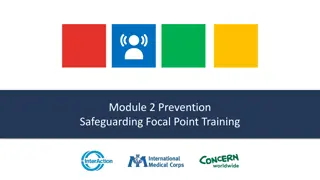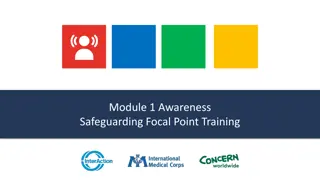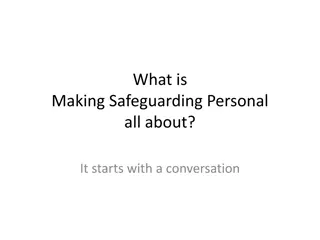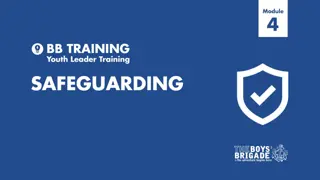Safeguarding Focal Point Training Overview
This training module focuses on enhancing the skills of Safeguarding Focal Points (SFPs) to disseminate information among staff, develop relevant safeguarding messages for communities, support safeguarding assessments, and collaborate effectively with other SFPs. It includes sessions on refresher training, ground rules, raising awareness with staff and communities, and key safeguarding messages.
Download Presentation

Please find below an Image/Link to download the presentation.
The content on the website is provided AS IS for your information and personal use only. It may not be sold, licensed, or shared on other websites without obtaining consent from the author.If you encounter any issues during the download, it is possible that the publisher has removed the file from their server.
You are allowed to download the files provided on this website for personal or commercial use, subject to the condition that they are used lawfully. All files are the property of their respective owners.
The content on the website is provided AS IS for your information and personal use only. It may not be sold, licensed, or shared on other websites without obtaining consent from the author.
E N D
Presentation Transcript
Module 2 Prevention Safeguarding Focal Point Training
Learning Objectives SFPs will be able to: Understand what information to disseminate among staff including through staff training Understand how to develop relevant safeguarding messages for communities Support safeguarding assessments Liaise effectively with other SFPs to contribute to collective PSEA measures, and coordinate with other actors to ensure appropriate referral pathways SFP Training
Session 0: Refresher SFP Training
Ground Rules Ensure you have your preferred name showing Please mute while others are speaking Please keep your video on unless you have connection issues Please use the chat box / or raise hand Only step away from your computer during assigned breaks Please participate as much as possible SFP Training
Session 1: Raising Awareness SFP Training
Raising Awareness with Staff and Communities Who are the different groups [staff/communities] you want to target? What information do you need to share? How will you share the information? [Additional: what internal or external resources can you draw on? For example, training materials, communication strategies, or any technical advisor, etc.] SFP Training
Key Messages We all have responsibility for safeguarding and to promote a positive safeguarding culture Zero tolerance for harm and abuse Duty to report - Speak Up! Inaction is not an option Maintain confidentiality at all times Report suspicious, actual, historic, and anonymous safeguarding concerns immediately We all have a duty of care to one another to every child, woman, and man that we are there to serve and support in the community, and to our work colleagues, to act in their best interests to ensure their safety and to act to eliminate or minimize any risk of harm SFP Training
Useful Resources IASC 6 principles No Excuse for Abuse film Say No to Misconduct film Organizational code of conduct translated into local language(s) Resource 7: Template training agenda [or other alternative from the organization] SFP Training
Conclusions SFPs play a key role in raising awareness on safeguarding and should work with Heads of Office and other key staff to develop, strengthen, and implement strategies for raising awareness with staff and communities Communication strategies should consider who they are targeting, what information needs to be shared, and how they will share it There are many resources that SFPs can draw on, including safeguarding advisors, training resources, and communication materials. It is important for SFPs to link with safeguarding staff at headquarters to ensure information and updates are quickly disseminated. SFP Training
Session 2: Safeguarding Assessments SFP Training
Conclusions SFPs may be involved in conducting safeguarding assessments at the country office level, which can assess the policy environment, training, and related issues. This can help inform country teams and their safeguarding workplans. It is important to regularly review the findings of this assessment to identify any new issues and to update mitigation strategies. SFP Training
Session 3: Working with Safeguarding Networks SFP Training
Safeguarding Networks What resources exist in-country on safeguarding (e.g. national level safeguarding/PSEA networks, inter-agency PSEA coordinators, other agency SFPs, and local safeguarding actors such as government bodies or child rights organizations)? What information would be useful to ask other actors? Who is best placed to provide information on any referral mechanisms in place? What information can you share when talking about safeguarding in your organization with external actors? Is there anything you cannot share? SFP Training
Conclusions In-country safeguarding networks can provide valuable information and support to SFPs on safeguarding. It is important to understand what information can be shared with others, and what should not be shared, as well as what information is useful to gain from other actors. Ensure sufficient time is allocated to identifying and networking with relevant safeguarding focal points and networks. SFP Training
Session 4: Additional Sessions SFP Training
Online Assignment |BOND Reporting Case Studies What are the key issues with the reporting process highlighted in this case study? 1. What reporting pathway would have been used if this situation had arisen in your organization? Would it have led to a different outcome than the one in the case study? 2. What recommendations would you make to improve the reporting process in this case study? 3. SFP Training
Wrap-up SFPs play a critical role in raising awareness of safeguarding with staff and may also support programs to do this with communities. SFPs may be involved in conducting safeguarding assessments at the country office level, which can help inform country teams and their safeguarding workplans. SFPs should liaise with Safeguarding Focal Points from other NGOs and UN agencies in-country, and PSEA/Safeguarding networks where established. It is important for country offices to be aware of and, where appropriate, contribute to collective, inter-agency measures to prevent and address PSEA/Safeguarding violations. SFP Training
